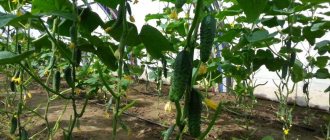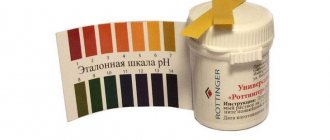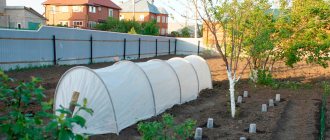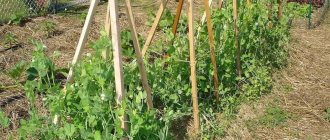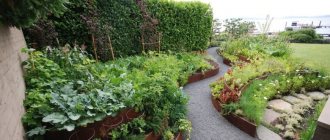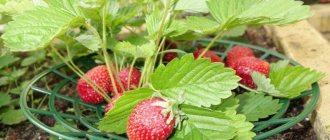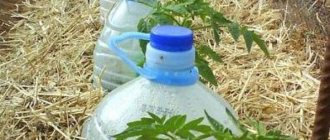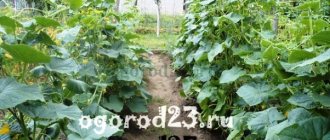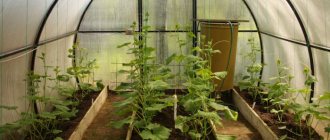The importance of soil for seedlings
Any seedlings are grown in the ground. The future harvest of tomatoes depends on its quality. If its composition is not sufficiently balanced, the plants will grow weak and sick, so you should not expect a rich harvest from them. In some cases, seedlings may even become sick and die. Therefore, it is important to know what soil to use for tomato seedlings , so that in the future the bushes will be strong, resistant to diseases and produce a large number of tasty fruits.
Soil requirements
A high-quality substrate with a properly balanced composition is very important for the rapid growth of tomato seedlings. To do this, you can use both store-bought and home-prepared soil.
Basic soil requirements for seedlings:
- Nutritional value - the soil must be saturated with micro- and macroelements necessary for growing tomatoes. This contributes to the rapid development of seedlings.
- Friability – the substrate for tomato seedlings must be breathable. This is necessary for the penetration of oxygen into the root system of the seedlings.
- Hygroscopicity - soil for tomato seedlings should easily absorb and retain moisture for a long time.
- Cleanliness – the soil composition should be free of weed seeds, insect larvae and other harmful impurities.
- Acidity – an important condition for proper soil for tomato seedlings is the pH level. It should not exceed 6.5 units.
At the initial stages of development, tomato seedlings are extremely sensitive and can develop normally only on thoroughly loosened, even “airy” soil, devoid of coarse lumps.
Composition of soil for tomato seedlings
The composition of the soil may include the following components:
- turf or meadow land;
- peat (lowland, middle, high);
- well-rotted leaf humus (its chemical composition will depend on the species of trees whose leaves were used to prepare compost. For example, there will be a lot of nut leaves in the humus; seedlings may not sprout);
- cattle humus (well rotted and frozen);
- sphagnum moss;
- soil from the garden (although experts do not recommend using it);
- fallen needles of coniferous trees;
- coconut fiber;
- rotted sawdust.
A mixture for planting tomato seedlings may or may not contain the following components:
- perlite;
- hydrogel;
- sand;
- vermiculite
Important! Perlite moistened with water is safe for humans. But perlite dust that gets on the lungs is very toxic.
The following substances are often (but not always) used as auxiliary components:
- chalk;
- wood ash;
- dolomite flour;
- lime.
Advice! Wood ash is added to the soil as a preventive measure against diseases and pests, as well as as a fertilizer and natural soil deoxidizer. Depending on the type of wood, the chemical composition of the ash is determined.
Optimal soil moisture for tomatoes
Tomatoes do not tolerate wetlands. If the site is swampy or groundwater is close to the surface for most of the summer and autumn seasons - at a distance of 70-80 cm for tomatoes up to 1 m high and at a distance of 1 m for giant tomatoes, then the site must be drained.
If a high groundwater level is observed after the snow melts in the spring (while the seedlings are growing on the windowsill or in the greenhouse) or briefly after rainstorms, drainage of the site is not necessary.
- Characteristics of tomato varieties
- The most delicious varieties of tomatoes
- Caring for tomatoes during flowering - proper planting, feeding and fertilizing tomatoes (105 photos)
Drainage is a troublesome, expensive, labor-intensive and not always feasible task (there is not always a reservoir or drainage collector nearby where wastewater can be discharged). Therefore, in some cases it is worth considering the possibility of creating bulk beds 20-30 cm high or stationary raised beds fenced with boards, slate, polycarbonate or any available materials.
Unacceptable soil mixture components
Under no circumstances should such components be added to the soil mixture for growing tomato seedlings.
Manure
- tomatoes don't like it;
- it increases the acidity level of the soil;
- it contains a lot of nitrogen (green mass will be released);
- There is a possibility that pathogens may be present in the manure.
Poorly rotted leaf humus
Tea leaves, fresh manure and poorly rotted leaves begin to decompose when they get into the soil. They produce a large amount of heat, which can burn the seeds. If the crops are able to germinate, the seedlings will still die due to the high temperature. In addition, organic components, when decomposed, reduce the amount of nitrogen in the soil, which is very harmful for young seedlings.
Soil with clay
Soil containing clay cannot be added to nutrient soil mixtures for growing seedlings. Clay makes the soil denser and heavier, making it difficult for air and moisture to pass through.
Namely, these properties of the soil are very important for seeds and young seedlings; without them, the seedlings will get sick or die.
Soil collected from a highway or chemical plant
You should not collect soil near a busy highway or near chemical plants. This soil contains heavy metals, which are easily absorbed by seedlings during growth.
Also, you cannot add hay dust and soil with insects, worms and weeds to the mixture for germinating seeds.
Advice! It is not recommended to use bird droppings, as they contain a high nitrogen content, and horse droppings, as the tomatoes will be tasteless.
Inorganic soil components
The structure of soil for seedlings, its heat capacity and ability to retain moisture largely depends on inorganic components.
| Inorganic filler | Purpose | Recommendations |
| river sand | Baking powder | Coarse river sand without clay inclusions is washed well with running water and calcined in the oven. |
| Perlite | Baking powder, increases the soil's ability to absorb moisture | Sand substitute |
| Hydrogel | retains moisture and releases it gradually | When growing a small number of seedlings, hydrogel is added to the soil at the rate of 20 g per 2 liters of soil. An undeniable advantage for summer residents is that you can water the seedlings once a week. |
Attention - this is unacceptable
When preparing soil mixtures, summer residents are worried about the question: “What should I add to the soil for seedlings?” It is very important to solve the second question: “What should not be in the soil for tomatoes?” All efforts will go down the drain if the soil contains:
- weed roots and seeds;
- toxic products;
- insect larvae;
- clay and other binding materials.
The greatest danger to seedlings (and adult plants as well) are unfermented organic fertilizers - manure, unripe humus, etc. When organic matter decomposes, heat is released, which “burns” young seedlings. The “benefits” of using such “natural” fertilizers are highly questionable.
How to prepare and disinfect soil at home
Self-made soil mixture must be disinfected before use. This is important for a mixture of any origin - fungal spores and rot bacteria cannot be seen.
The simplest and very effective method is to treat the seedling mixture with a solution of potassium permanganate. The recipe is very simple, for about 15-20 liters of soil:
- 3 g potassium permanganate;
- 10 liters of water.
It is good to water the soil with this solution. Consumption depends on the characteristics of the soil.
There are often recommendations to “steam” the soil. In a city apartment, performing such “steaming” is problematic: putting the soil in a closed tank and treating it with steam in a water bath for several hours to disinfect it is too labor-intensive.
How to choose soil for tomato seedlings?
If you cannot prepare the soil yourself for planting tomato seeds for seedlings, a ready-made substrate can be purchased at the store.
To select the correct mixture, follow the instructions below:
- First, determine what kind of soil you need to use - universal or special. Beginners are recommended to use a universal soil mixture.
- The package with soil must have a label or seal with instructions for use, the chemical and mechanical composition must be indicated, as well as who produces this soil mixture. If the packaging does not contain this information, especially about the composition of the soil, it is better not to purchase it.
- Study the chemical composition of the soil. A good mixture will have at least 3-4 components.
When studying the composition of the soil, pay attention to the following:
- The soil should contain several types of peat, sand or vermiculite, and mineral fertilizers.
- All chemical elements must be in moderation. For some plant species, soil containing 300-400 mg/l of phosphorus, nitrogen, and potassium must be diluted.
The composition of store-bought mixtures can be as follows:
- Lowland and highland peat;
- Cleaned sand;
- Dolomite flour;
- Nitrogen – 300-550 mg/kg;
- Phosphorus – 300-550 mg/kg;
- Potassium – 450-850 mg/kg;
- Acidity level – 5.5-5.6 pH.
Advice! Or you can use less nutritious soil, but then add additional fertilizer.
How to make soil yourself?
Information: all preparatory work with the soil is carried out in late summer - early autumn.
Here are some soil recipes:
- Peat, sand, wood ash, turf soil in a ratio of 1:1:0.2:1.
- Peat, turf, sawdust, mullein in a ratio of 4:1:0.5:0.2.
- Wood ash, steamed sawdust, sand + 1 tbsp. spoon of nitrogenous fertilizer. This soil needs to be mixed well so that the fertilizer is distributed evenly.
- Soddy soil, rotted manure, sand and peat + 3 tbsp. l. nitrogenous fertilizer onto a bucket of soil.
You can find out more about soil for tomatoes with your own hands here.
Let's watch a video that tells you how to make soil for seedlings yourself: https://www.youtube.com/watch?v=LtXMzdISsJc
How to prepare soil for tomato seedlings with your own hands?
Many gardeners prepare the soil for growing tomato seedlings themselves. It must be remembered that each vegetable has its own preferences and needs, therefore the soil for different crops is made up of different components.
Advantages and disadvantages of homemade soil
Advantages:
- You can add the exact amount of components and the required amount of microelements, according to the recipe.
- An earth mixture assembled with your own hands will be cheaper.
Flaws:
- Long cooking time.
- You must follow the recipe.
- The soil may contain pathogenic bacteria and other organisms.
- You can spend a lot of time searching and purchasing the necessary components.
Features of preparing soil for seedlings
There are many recipes for preparing soil for growing tomato seedlings. Below we will present several such recipes that are most often used by experienced gardeners.
Watch the video! Land for seedlings of tomatoes, peppers and eggplants
Recipe No. 1
Garden or turf soil, peat and river sand in a ratio of 1: 1: 1. Combine the components and mix well, water with a nutrient solution, which is prepared as follows:
- for 10 liters of water;
- 25-30 g of potassium sulfate;
- 30 g superphosphate;
- 10 g urea.
Recipe No. 2
Take the same amount of garden or turf soil, well-rotted humus and peat. Add to the mixture:
- 0.5 l jar of ash;
- 2 handfuls of superphosphate.
Recipe No. 3
- Take turf or garden soil, well-rotted humus and river sand in a ratio of 2:1:1.
- Add 0.5 liters of ash to a bucket of prepared soil.
Recipe No. 4
Make up a mixture of peat, turf soil and cow manure (rotted and frozen) in a ratio of 16:4:1.
Add the following to the bucket of soil mixture:
- 3 liters of purified river sand;
- 10 g potassium chloride;
- 10 g ammonium nitrate;
- 25 g superphosphate.
Recipe No. 5
The soil mixture is composed as follows:
- 3 parts peat;
- ½ part mullein (rotted and frozen);
- 1 part sawdust.
Mix everything thoroughly and add the same substances as in recipe No. 4 per 1 bucket:
- 3 liters of purified sand;
- 25 g superphosphate;
- 10 g ammonium nitrate;
- 10 g of potassium chloride.
Recipe No. 6
Mix in equal parts:
- humus;
- peat;
- turf land;
- well rotted sawdust.
Add substances to the mixture per 1 bucket:
- 1.5 cups of ash;
- 3 tbsp. spoons of superphosphate;
- Art. a spoonful of potassium sulfate;
- 1 teaspoon of urea.
If the soil turns out to be very acidic, it must be deacidified. To do this, add 15 g of dolomite flour for every 1 kg of soil.
More details about determining soil acidity will be written below.
Advice! You can add crushed eggshells to the soil, this will improve the quality of tomato seedlings.
If it is necessary to increase the acidity of the soil, you need to add high-moor peat, as it has an acidic reaction.
To make the soil less dense, it is recommended to add perlite or vermiculite.
Important! There is no need to sift the soil through a sieve, as after watering it can become very compact.
Watch the video! Preparing the soil for seedlings of peppers, eggplants and tomatoes
Soil disinfection
Soil disinfection plays an important role in preparing it for planting seeds for seedlings. To prevent plants from dying and developing well, there should be no pathogenic larvae and bacteria in the soil.
Disinfection is carried out in various ways, which we will discuss below:
- Freezing. To do this, containers with soil are taken out into the cold in winter, then brought indoors and allowed to remain. Repeat this procedure several times. Often the soil is kept in a cold garage or barn, and 7 days before sowing the seeds for seedlings, they are brought indoors.
- Calcination . With this disinfection method, the soil is poured into a baking tray in a layer of no more than 5 cm and placed in an oven preheated to 70-90 degrees for 30 minutes. This procedure must be carried out in advance so that the soil is not sterile and beneficial microorganisms have time to colonize it.
- Steaming . The soil mixture is poured into a colander or cheesecloth and kept over boiling water for 10-15 minutes. A double boiler is also often used for this.
- Etching . The easiest way to disinfect. But it has one drawback - it will not get rid of weed seeds. Dressing is carried out using iodine (3 drops per 10 l), 1% solution of potassium permanganate, antifungal drugs, insecticides and fungicides.
Advice! To obtain the best result, it is recommended to use one of the methods described above, and then water the soil with a preparation that promotes the development of beneficial microflora (Fitosporin-M or 33 Bogatyr, containing beneficial microorganisms).
Checking the acidity level
Before sowing seeds for seedlings, it is necessary to check the acidity level of the soil mixture.
Important! Slightly acidic soil contributes to the infection of bushes by sour and blackleg.
Most often, to determine the acid-base balance of the soil, experienced gardeners use:
- litmus test;
- vinegar/hydrochloric acid;
- grape juice;
- chalk.
Litmus test
Litmus paper is freely available at pharmacies, garden stores, or hardware stores.
These are several strips of paper soaked in reagents that change color depending on the environment in which they are exposed. To check the acidity of the soil with litmus paper, you must follow the instructions:
- Soil is taken from different depths and different trays;
- gauze is folded 3 times and soil is placed in it;
- gauze with soil is dipped into a jar of clean distilled water, which can also be bought at a pharmacy;
- shake the jar a little and dip litmus paper into it for a few seconds;
- acidity is determined by the changed color of the piece of paper (all colors are written in the insert that comes with the set).
Vinegar/hydrochloric acid
This method belongs to the traditional methods of determining soil acidity. To do this, take a handful of earth and water it with vinegar or well-diluted hydrochloric acid.
- If bubbles appear on the surface of the soil, then we can talk about a normal level of acidity (pH is normal).
- If bubbles do not appear, then lime must be added to such soil.
Grape juice
A handful of earth is poured into a glass of grape juice. We can say that the soil is neutrally acidic if the juice changes color and bubbles appear on its surface for a long time.
Chalk
Determining the acidity level of the soil using this method is necessary as follows. You need to take:
- 2 tbsp. spoons of soil;
- 5 tbsp. spoons of warm water;
- 1 teaspoon of crushed chalk.
Next they follow the following algorithm:
- the above components are poured into the bottle;
- a fingertip is placed on the neck of the bottle, in which the air is squeezed out;
- the bottle is wrapped in paper so that the result is not affected by the heat of the hands;
- if there is not enough lime in the soil, then carbon dioxide will begin to form in the bottle and the fingertip will straighten;
- if the soil acidity level is slightly acidic, the fingertip should be straightened halfway;
- When the soil is neutrally acidic, carbon dioxide will not form and the fingertip will remain in the same state.
Description of main components
There are many soil recipes for sowing tomatoes using the following components:
Lowland or highland peat. It has neutral acidity, is poor in minerals, and is used as a soil loosening agent.- Rotted leaf compost. Used as a loosening agent, improving air and water permeability of the soil.
- Sawdust.
- Wood ash. A readily available source of calcium, magnesium and other minerals.
- Quicklime. Used to reduce acidity.
- Chernozem.
- Coconut fiber. Used to reduce acidity and protect soil from fungi.
- Sphagnum moss. Improves soil permeability and performs a barrier function, protecting it from bacteria.
- Superphosphate.
- Humus is rotted manure containing various minerals.
- Turf soil is soil taken from crops growing in meadows and pastures.
- Coarse-grained river sand without admixtures of clay and stones. Used as a leavening agent.
- Agroperlite. A rock whose properties resemble river sand.
- Vermiculite. Aerates the soil and prevents it from becoming infected with fungi.
The best purchased soils
The stores have a large selection of a wide variety of soils - peat-based, with vermicompost, with vermiculite, with coconut fiber. Below is a ranking of the most popular:
Terra Vita
According to experienced gardeners, this is the best soil mixture for growing tomato and pepper seedlings. Packaged in bags from 5 to 50 liters. Ready to use. Contains all necessary nutritional elements and leavening additives. It is made on the basis of vermicompost produced by Californian worms.
Sturdy
Suitable for growing all types of vegetable seedlings. It is made from a mixture of high-moor and low-lying peat, additionally enriched with mineral fertilizer. Thanks to the optimal ratio of nutrients, it ensures accelerated growth and development.
Magic bed
Ready soil for growing seedlings of all nightshade crops. Contains a full range of essential nutrients and microelements. Thanks to its optimal composition, it increases resistance to disease. The available batteries last for 1 month. In the future, it is necessary to use fertilizing.
Tomato growing technology
For normal development, tomato plants require an air temperature of at least 15°C. A prolonged decrease in temperature below 10°C leads to the fall of flowers and delayed fruit ripening. At an air temperature of 30°C, plant growth slows down, and at 35°C it stops completely. When growing tomatoes in greenhouses or greenhouses during the daytime, it is necessary to create a through movement of air. This lowers the temperature in the greenhouse and helps pollination. Although tomatoes are drought-resistant plants, they have a high water requirement. In dry weather, during budding and ovary growth, plants need abundant watering, otherwise, if there is a lack of moisture in the soil, flowers and ovaries will fall off, and blossom end rot will develop during fruit formation.
However, tomatoes do not like soils with close groundwater. This causes plants to stretch and leaves to grow excessively. High humidity and long-term rainy weather create conditions for plant disease with brown spot and late blight and make fertilization difficult. It is not recommended to grow tomatoes after potatoes, peppers, and eggplants, since these crops belong to the same family and have common diseases.
RELATED MATERIALS
Almost every summer resident grows tomatoes. And everyone has their own secrets on how to get the most...
Tomato seedlings must be strong and healthy - then after planting in the ground they will turn into...
4,33
Nowadays, ready-made fertile soils for any purpose and in any quantity can be purchased
Important ..
4,5
1
Perlite and vermiculite belong to the group of inorganic soil improvers. Their main advantage is...
5
On May 11, 2022, the most delicious and beautiful tasting of cherry tomatoes took place at the POISK Agroholding. On the …
4,75
1
Cherry tomatoes are becoming increasingly common not only in large farms, but also in ...
5
When you hold a tomato weighing half a kilo in your hands, it’s hard to imagine that these vegetables were once grown...
4,75
63
In the conditions of central Russia, large-fruited tomatoes are grown in film or glass containers...
4,67
7
In the middle zone you can’t grow tomatoes without pinching, we’ll tell you how to do it correctly.
How to prepare soil mixture at home for tomatoes?
When purchasing a ready-made soil mixture, there is a chance to get acidic peat soil.
Even with the addition of mineral fertilizers, the required development of tomato seeds intended for sowing in seedling soil may not be obtained. For this reason, seedling soil for tomatoes is made manually by experienced summer residents. How to prepare soil for tomato seedlings at home? It is prepared by mixing. To do this, polyethylene is spread on the ground and each component is poured in the required proportions.
Seedling soil is produced as follows:
- To one part of the turf land, one part of peat and river sand is added.
- The resulting mixture is thoroughly mixed and then watered with a nutrient solution consisting of 25-30 grams of superphosphate, potassium sulfate and 10 grams of urea per 10 liters of water.
Another variant:
- Turf soil, peat and humus are mixed in equal proportions.
- Then it is done like this: two matchboxes of superphosphate and half a liter of can of ash are added to one bucket of substrate.
At the initial stage of seed germination, they do not require many microelements. Therefore, you should not excessively use fertilizers when preparing the soil for seedlings; the original soil is nutritious in itself. Fertilizers are required at the moment when the first leaves appear. Additional nutrition in liquid form is usually applied several weeks after germination.
To accurately prepare the right soil for tomatoes, watch the video:
Soil: ready-made or homemade?
Not only beginners, but also experienced gardeners often face the question: “So, should I make soil for tomatoes myself, or should I buy a ready-made mixture?” If you decide to purchase soil, then be sure to treat it with the biological solution “Fitolavin”, taking 2 ml per liter of water. You cannot be completely sure that the purchased land did not come into contact with anything during harvesting.
Good soil for greenhouse vegetables is obtained from a mixture of turf and humus soils, taken in equal proportions and loosened with sawdust. Additionally, you can purchase “Tomato and Pepper” soil, in which all the necessary substances and elements are more accurately calculated. It is sold in plastic bags of 4 kg, and you need to add 3 kg per 1 m2, separately into each hole. Here we are talking about the traditional version. Also use the popular coconut substrate, which is especially good for seedlings.
But note that the most dangerous moisture for greenhouse tomatoes is soil moisture. Wet, compacted soil quickly promotes the development of all kinds of diseases. Check the soil you have prepared for moisture: make a lump, and if it crumbles easily when touched, then everything is in order.
Many craftsmen use almost nothing but sand as a substrate so that it instantly dries and is saturated with oxygen. But then the process of growing tomatoes is already different from the usual one.
Remember one very important rule: the soil made for the greenhouse should smell like earth! Moreover, it smells pleasant, but any foreign smell indicates that the substrate lacks organic matter or contains other undeclared elements. Although it is possible without soil at all:
Although it is possible without soil at all:
What kind of soil do tomatoes like?
It is recommended to choose soil for tomatoes with the following properties:
- loose, not compacted, and therefore air- and water-permeable;
- quickly warms up;
- rich in nutrients (nitrogen, potassium, phosphorus) and mineral elements (calcium, magnesium);
- slightly acidic, that is, with a pH value of 5.5-6.5 (smaller numbers indicate an acidic reaction, and more than 7 indicate an alkaline reaction);
- not infected with pests and infectious diseases.
The following composition meets the listed requirements: peat - 60%, sand - 20%, compost - 20%.
Preparing the soil for dill
Dill is an early crop that is one of the first to be sown in the spring, so if the site is prepared in advance, this can speed up the harvest period.
The soil for dill is dug deeply, combining this with the removal of parts of weeds. On poor soil, you can add 70-80 g of wood ash and add superphosphate and potassium salt at a rate of 15-20 g per square meter.
The most suitable area for dill is a well-lit one.
, however, if the piece of land on which you planned to grow dill is in light partial shade, then it’s okay, it will give a good harvest there too.
Advantages and disadvantages of homemade soil
If you don’t have the money or other opportunity to purchase a professional soil mixture for tomatoes, then don’t be upset. A large number of gardeners and vegetable gardeners make their own planting substrates. The main thing is to use the right components in the right proportions. This will prepare the best soil for the plants.
Positive sides:
- many components of the soil mixture can be collected for free in a forest, park or garden;
- you can experiment with the composition, choosing the appropriate “recipe” that the plants prefer;
- If suddenly there is not enough soil mixture during planting, the missing volume can be made on the spot.
Negative sides:
- It is advisable to disinfect (fry or steam) the soil before use. As a last resort, water the pots with seedlings with a solution of fungicides and insecticides;
- significant investment of time and effort in preparation;
- if you lack experience, you can prepare a substrate that is not suitable for tomatoes;
- Without special instruments (pH meter), it is impossible to determine the exact acidity of the tomato substrate.
Soil acidity for tomatoes
Tomatoes do not grow well in acidic soil and prefer neutral or slightly acidic soil. Therefore, it is necessary to determine the acidity of the soil for tomatoes using litmus paper. If the litmus test results in an acidic reaction, the acidity must be tested in the laboratory.
You can also roughly estimate the acidity of the soil using 9% vinegar: pour a little vinegar on the ground - if the soil is alkaline, foam will form; if the soil is acidic, there will be no reaction.
The maximum permissible acidity level should be no more than 7, or even better – 5.5-6.
If necessary, soil acidity can be reduced by liming the soil. The work is carried out in the fall, the soil is evenly sprinkled with quicklime in an amount of one to one and a half kg per m², and dug up onto the bayonet of a shovel (20-25 cm).
Liming can be carried out in early spring, but it is still preferable to perform this operation before winter. In spring, it is better to use slaked lime, chalk, ash, dolomite or limestone flour.
